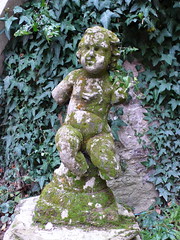I heard a lot at college about archival quality, durability of art works, and the expected lifespan of a work, and as a result of that, whenever I see a work of art, I think about how long it has lasted, and how long it will likely last into the future. I think about the artist's choice of materials, and about how the material choice influences the final result of the work.
The stone cherub pictured here, for instance, was probably carved in the 16th or 17th century, and may have been sitting in that spot for most of the intervening time (although I doubt that, since the castle courtyard around it has plainly been renovated at least twice in that interval.) I think... ok, four or five centuries isn't too shabby. The person who carved it probably didn't expect it to last that long. This all assumes it's not a cast replica of an original piece. I didn't actually poke at it long enough to even make an educated guess about that.
How long should art last? Does it lose relevance, with time? Does it gain worth over time? There is a certain mindset that holds endurance to be a desirable trait, but clearly a cherub doesn't mean the same thing now, as it might have at the time when this figure was carved or cast. Should a thing last until someone decides to smash it? Should it last until the artist can come up with something better? What if art were always ephemeral, like so much else in the universe? In a sense, it is, but I'm not trying to have that kind of philosophical inquiry right now.
Andy Goldsworthy seems to want his to last exactly as long as it takes to make good photos, unless of course he's having it mortared in place by professional stone masons. Harvey Fite, on the other hand, actually sculpted an abandoned stone quarry, turning it into a permanent, unmovable work of art entitled "Opus 40", which is now the name of the NPO that maintains it. Theoretically, performance art is the ultimate in ephemeral art, as it cannot exists beyond the memory of the last living person who saw it. Buster Keaton died a long time ago, but his art continues to exist, because we have film of it. When that's gone, Buster Keaton's art is gone.
Where is it all going? I don't know. I mostly just wanted to test the ability to post to this blog from my flickr account. The obvious age and sturdiness of this carved piece stands out as a stark contrast to some pieces I saw yesterday, from Kris Kuksi, which struck me as brilliant in many ways, with the Achilles heel of being made from materials that are notorious for lack of durability.

2 comments:
I think maybe art should be ambiguous or compelling enough that it can be given new meanings over time depending on the audience. As for its durability- well, I wish they made film stock more durable so we hadn't lost so many silent movies.
At least they made the leap from "extremely flammable" film stock, to "subject to the depredations of time & weather"...
Post a Comment